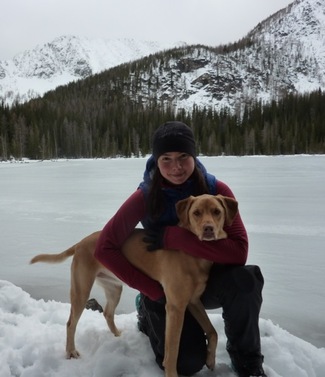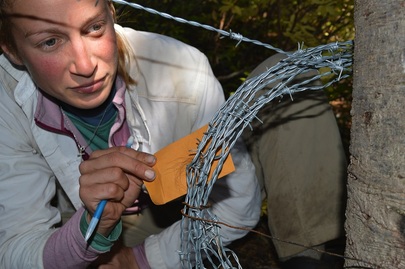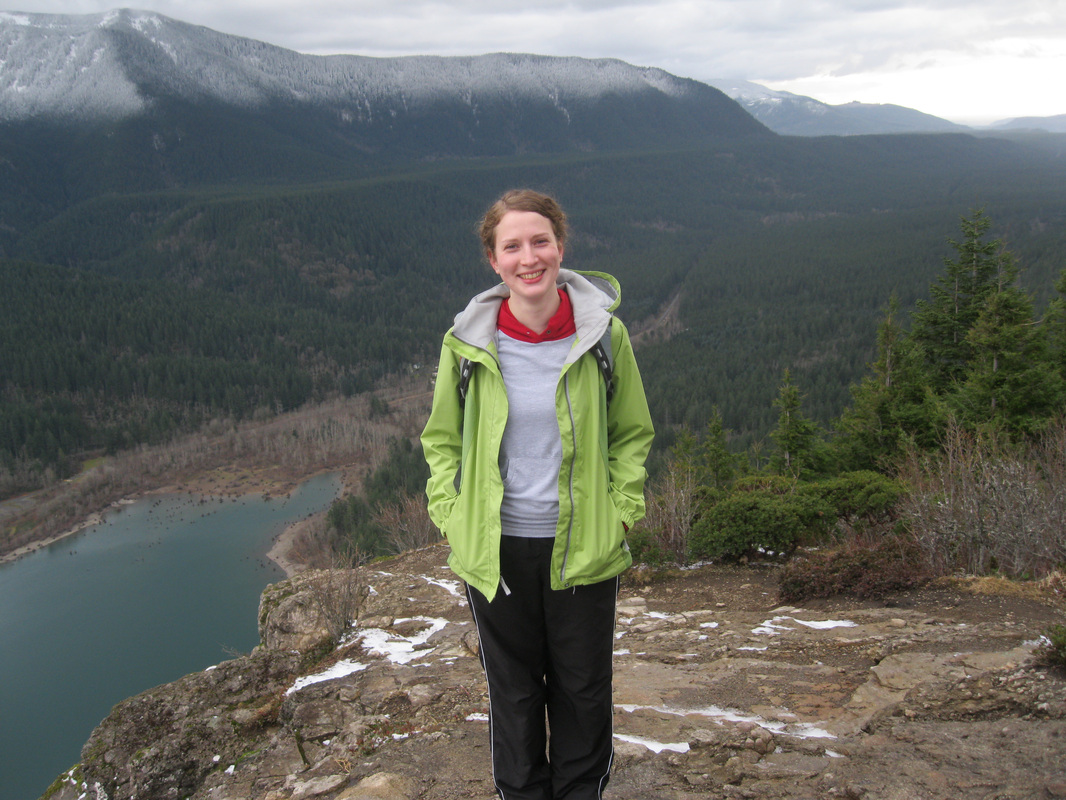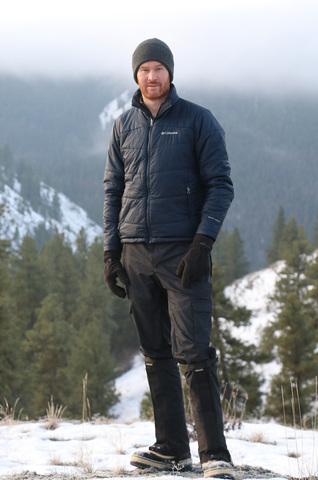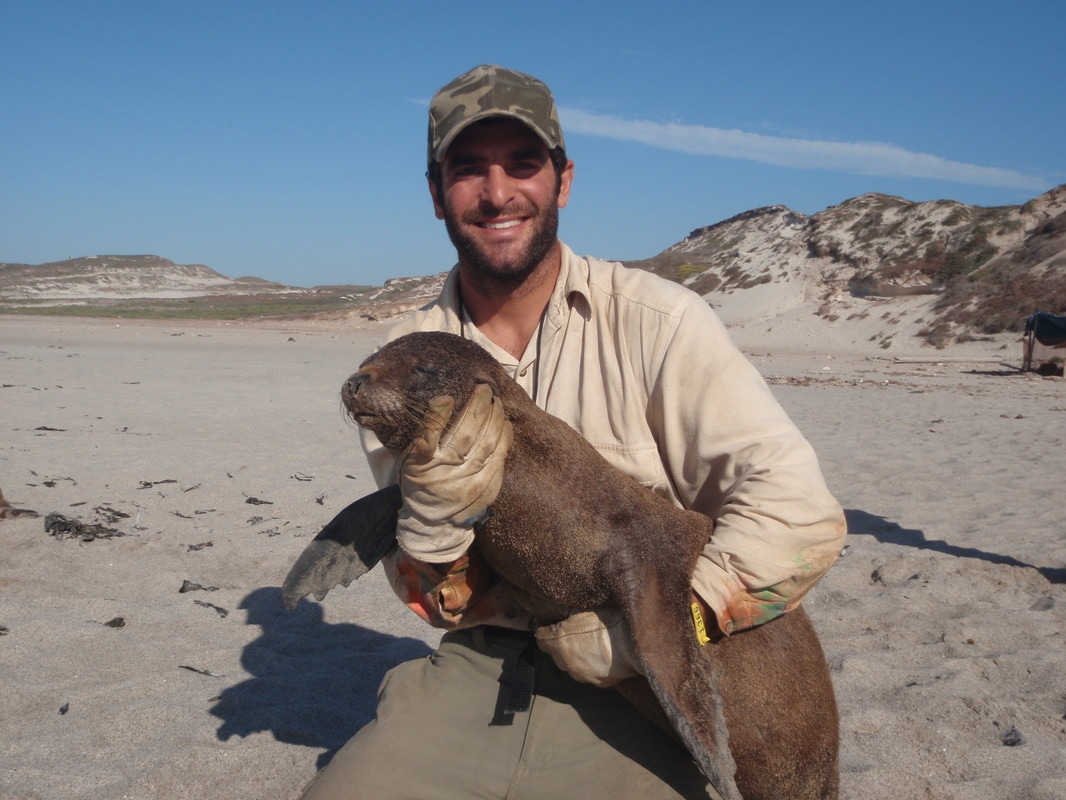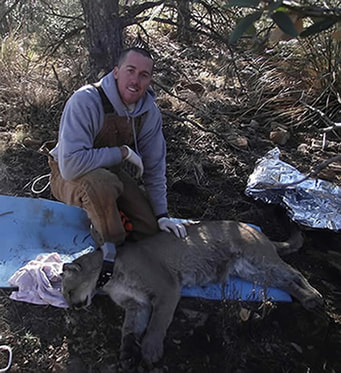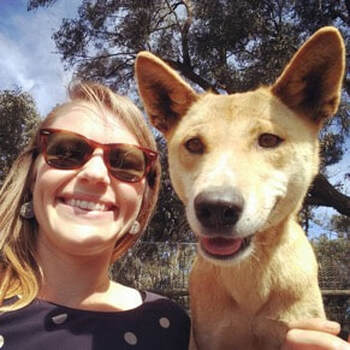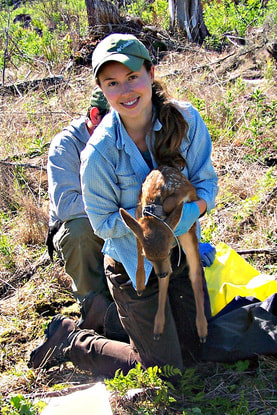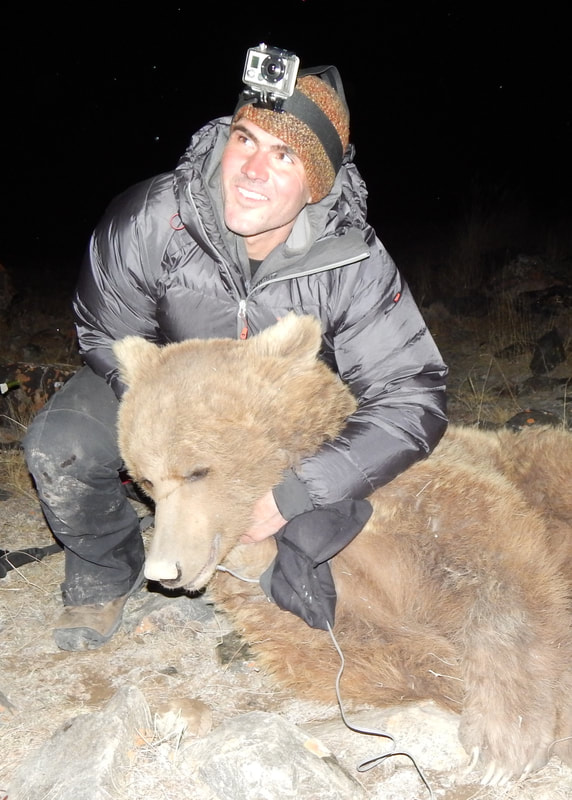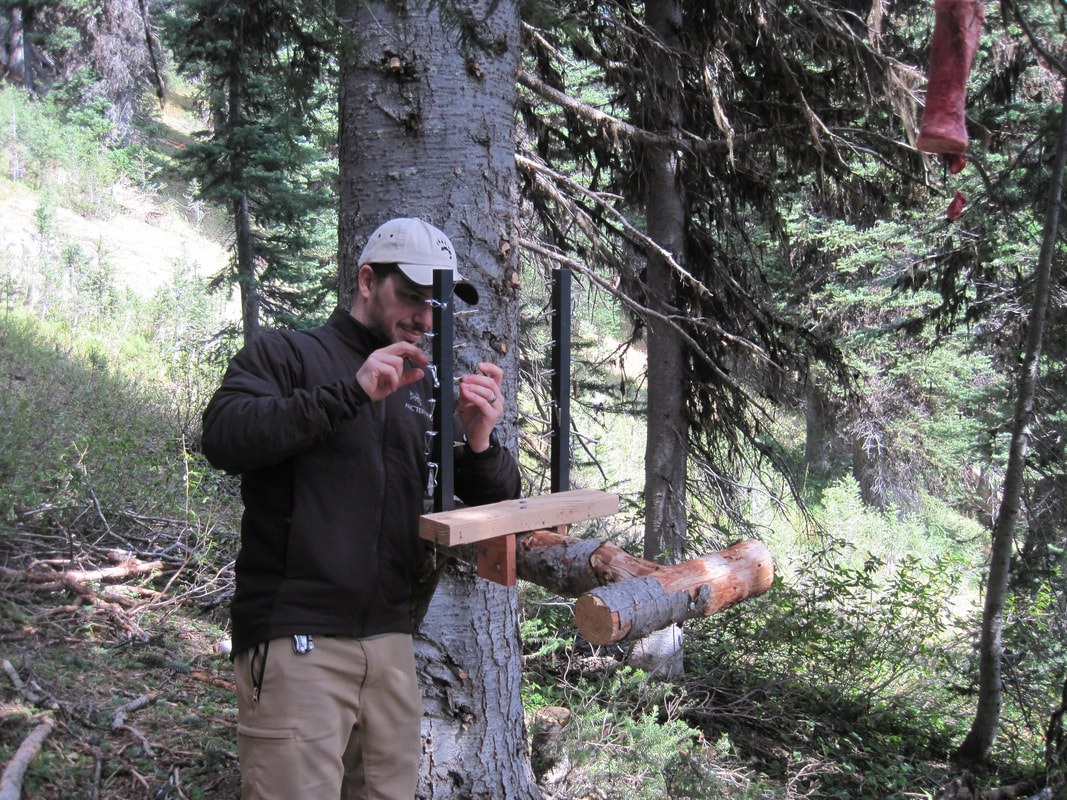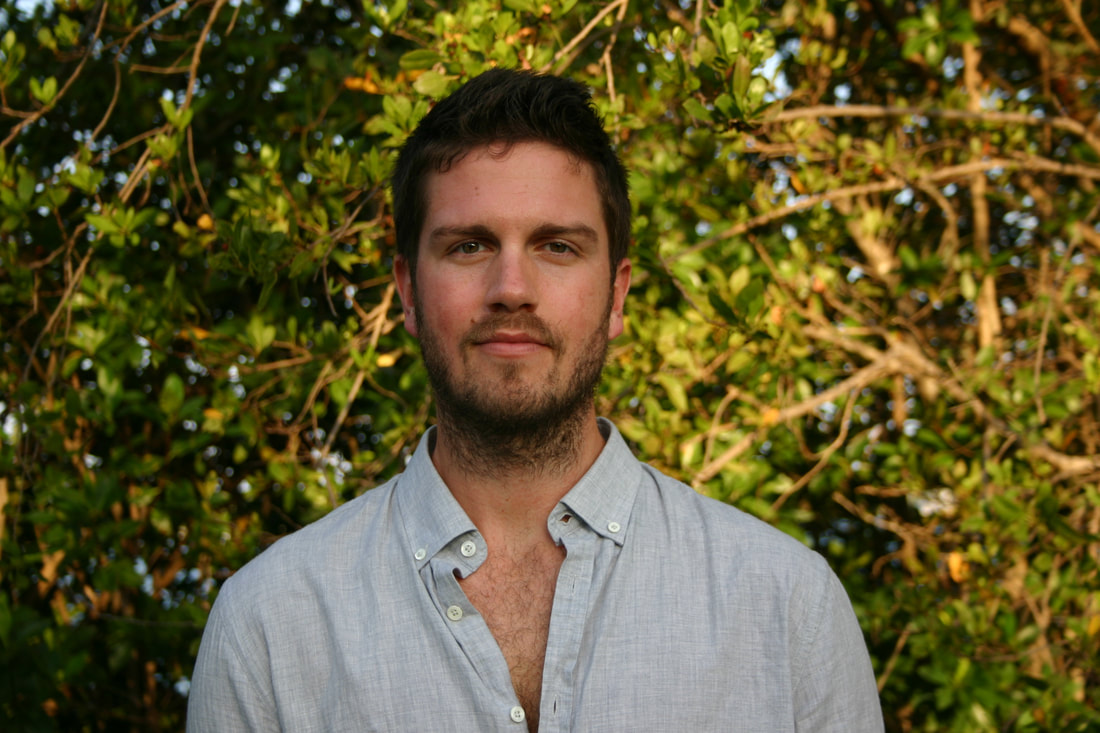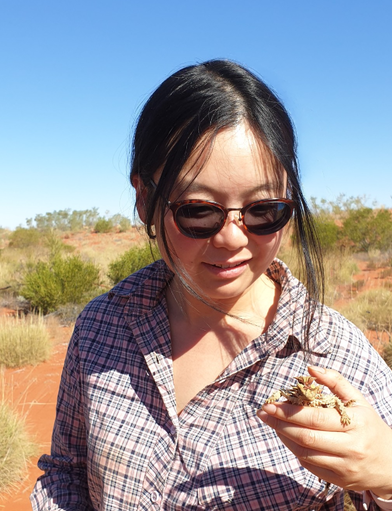|
Jessica Bolis, MSc
Jessica received her Bachelor of Science in Wildlife Science from the University of Arizona and then went on to conduct field research internationally and throughout the U.S. for 10 years, primarily focusing on mammalian carnivores. In 2012 she completed her Master of Science degree at the University of Washington, conducting research for the Forest Service's North Cascades Wolverine Study to determine how topography, vegetation, and animal behavior affect the accuracy and acquisition rates of Argos satellite telemetry collars used to track wolverines. Jessica is currently working as a field operations manager for the Pacific Southwest Region of the National Ecological Observatory Network (NEON).
|
|
Kristen Richardson, MSc
Kristen received both her Bachelor of Science and Master of Science degrees at the School of Environmental and Forest Sciences. For her graduate research she conducted non-invasive genetic sampling of black bears in the North Cascades Ecosystem (NCE) of Washington State. Using genetic and detection data, she examined associations of black bears with habitat and human activity variables across the entire NCE. To date, no other research has investigated patterns of black bear relative abundance in Washington across such a large geographic expanse. Kristen is currently working as a wildlife biologist for the Quinault Indian Nation.
|
|
Kelsey Vitense, MSc
Kelsey completed her masterʼs degree in Quantitative Ecology & Resource Management (QERM) in 2014 under the supervision of Aaron Wirsing and Jim Anderson. She studied the theoretical impacts of habitat loss and generalist predation on predator-prey cycles using reaction-diffusion-advection models. She found that habitat disturbances can have a variety of consequences for cyclic systems depending partly on the nature of specialist predator-prey interactions and the extent to which the disturbances increase generalist access to prey. Ultimately, however, habitat loss and generalist predation lead to the attenuation or loss of cycles, consistent with observations of decreased cycle amplitude, increased predation rates, and increased habitat fragmentation in the southern ranges of cyclic species.
Before graduate school, Kelsey obtained a BA in mathematics from Grinnell College in 2008 and then worked for three years in a neuroimaging lab at the University of Iowa. She is currently a PhD student at the University of Minnesota working with John Fieberg on the dynamics of regime shifts between clear and turbid states in shallow lakes. |
|
Dr. Thomas Newsome
Thomas joined the Predator Ecology Lab in 2013 as a visiting Fulbright scholar from The University of Sydney, Australia. During his time in the U.S. Thomas investigated interactions between gray wolves, coyotes and red foxes across North America with his co-host, Professor William Ripple, at Oregon State University. In collaboration with members of the Predator Ecology Lab, Thomas completed a global review on the ecological effects of providing resource subsidies to predators. He also completed a project that brought together Australian and American researchers to investigate the feasibility of undertaking a reintroduction study involving Australia’s apex predator, the dingo. Thomas continues to collaborate with the Predator Ecology Lab through the Washington Wolf and Washington Predator-Prey Projects and via research projects investigating predator ecology and behavior. Until recently, Thomas worked as a postdoctoral research assistant in the Desert Ecology Research Group at The University of Sydney. He is currently a Lecturer (Early Career Development Fellow) at The University of Sydney.
Website http://thomasnewsome.com/ |
|
Dr. Linda Uyeda
In 2015, Linda completed a dissertation focusing on the water monitor lizard, Varanus salvator, in Indonesia. This large (3m in total length) species adapts easily to areas of anthropogenic disturbance, raising the concern for human-wildlife conflict in areas where V. salvator and human activities overlap. By exploring community attitudes and V. salvator space use in an area of regular anthropogenic food subsidy, Linda’s research increased understanding of how human and V. salvatorbehaviors may influence one another.
Development of Indonesian language skills was essential to the completion of Linda’s research; in 2009-2010 and 2011-2012 she was supported in this effort as a Foreign Language Area Studies (FLAS) Southeast Asia-Indonesian Language Fellow. Linda earned an MA in International Studies from the University of Washington’s Jackson School in 2010 and a MS in Biology for Teachers from the University of Washington in 2008. From 2015-2017, Linda worked in Southern California as a California Condor Recovery Program Wildlife Biologist with the US Fish and Wildlife Service. Linda next spent a year as a Senior Biologist with zoOceanarium Group / Worldwide Zoo Consultants LLC in Dubai, United Arab Emirates (UAE). She is currently an Animal Keeper with Seattle's Woodland Park Zoo. Website http://lindauyeda.weebly.com/ |
|
Jeff Harris, MSc
Jeff earned an undergraduate degree (BSc) in biology, with a marine emphasis, from Western Washington University. His Masters research at the University of Washington focused on the timing and factors that influence an individual’s transition to nutritional independence (weaning) in California sea lions. This transition is the most critical part of a sea lion's life history, for during this period an individual’s risk of mortality is greatly increased. To better understand post-weaning survival of California sea lions, his graduate research also addressed the impacts of shark predation on the juvenile age class and how this predation pressure has changed through time. As parr of this second project component, Jeff examined the seasonality of predation events on California sea lions, as well as the size and species of sharks responsible for the attacks. The majority of his research was conducted on the breeding rookeries of San Miguel Island, CA.
Jeff is currently working as a research biologist for NOAA at the National Marine Mammal Laboratory, in Seattle, where he participates in a variety of marine mammal projects from Southern California to northern Alaska. |
|
Dr. Justin Dellinger
After graduating from the University of North Carolina Wilmington in 2008 with a B.S. in Biology, Justin undertook a graduate position at Auburn University under Drs. Troy Best and Todd Steury studying foraging and spatial ecology of red wolves in northeastern North Carolina. He earned an M.S. in Biology in the spring of 2011 and then headed to Arizona to work as a wildlife researcher studying mountain lions in collaboration with the San Carlos Apache Tribe. In the autumn of 2012, Justin joined the PEL as a PhD student. His dissertation research focused on consumptive and non-consumptive interactions between recolonizing gray wolves and two deer species (mule and white-tailed) in a managed (i.e., human-modified) landscape of eastern Washington. Justin defended his dissertation in the winter of 2018 and is now a senior environmental scientist in the Wildlife Investigations Lab of the California Department of Fish and Wildlife, where his work focuses on the ecology and management and cougars and wolves.
|
|
Dr. Lily van Eeden
I recently completed my PhD at The University of Sydney, Australia, after visiting the UW Predator Ecology Lab for ten months as a Fulbright Scholar to learn from North American experiences in predator management. In Australia, my research focuses on the largest terrestrial mammalian predator in Australian ecosystems – the dingo. Dingoes are controlled across the continent using mostly lethal methods to prevent attacks on livestock, and I’m interested in the human dimensions that shape this management. My research to date has focused on public awareness and acceptance of management practices as well as surveys of farmers to determine what influences how they protect their livestock. The focus of Australia’s management is baiting using 1080 poison, a practice that has been illegal in the USA since 1972, so I’m interested in understanding how a balance is met between livestock production and carnivore conservation in the USA.
My interest in the human dimensions of wildlife management was inspired by around eight years’ experience working as an ecologist, mostly in Australia but also in the USA, China, and the UK. Working in different cultural settings brought me to realise the importance of understanding what shapes human actions in implementing successful environmental management. I then completed an interdisciplinary MSc in biodiversity conservation at the University of Oxford in 2015 before starting my PhD in Sydney. Website: lilyvaneeden.wordpress.com |
|
Dr. Carolyn Shores
I was a Ph.D. student and NSF Graduate Research Fellow in the Predator Ecology Lab. My broad research interests are interspecific competition, predator-prey interactions, and trophic cascades ecology.
My Ph.D. research was on the ecosystem impacts of wolves in multi-use landscapes. My dissertation is focused on how wolves change coyote populations, and how this in turn changes the rate of coyote predation on mule deer fawns. I employ a combination of non-invasive scat and track surveys, GPS collaring, radio telemetry and kill site analysis in my field work. Mule deer are declining throughout the American west due to unknown causes, and my research will inform mule deer conservation and management, as well as our understanding of the impacts of predators in multi-use landscapes. My field experience includes work on trophic cascades ecology in Canada, small mammal conservation in the North Cascade Mountains, Canada lynx remote camera and live trapping in Colorado and Washington, and wolf ecology in Italy. |
|
Dr. Shannon Kachel
Shannon's PhD ('21) dissertation research on the ecology and conservation of sympatric large carnivores in the Pamir and Tien Shan Mountains of Tajikistan and Kyrgyzstan. Enjoying the flexibility of a NSF Graduate Research Fellowship, and the reliable support of Panthera, an organization dedicated to the conservation of all of the world's wild felids, Shannon's research focused on (1) the non-consumptive effects of sympatric snow leopards and wolves on their shared prey – ibex and argali – and indirectly, each other, and (2) developing novel hierarchical approaches to map and understand carnivore (snow leopards, wolf, bear, and lynx) distributions and depredation risk to livestock at multiple scales from unstructured data in order to better allocate conservation resources. Shannon was prepared for his PhD studies by a BS in Wildlife Science from the University of Washington ('08), four years of work as a Wolf Recovery Biologist for the Nez Perce Tribe, and an MS in Wildlife Ecology and Conservation from the University of Delaware ('14). Shannon is currently a Conservation Scientist with Panthera's Snow Leopard Program.
|
|
Michael Havrda, MSc
Michael aims to conduct wildlife research that not only advances our understanding of wildlife species and their ecological roles but also results in the development of scientific and practical methods of management and conservation. He is particularly interested in noninvasive carnivore research and spent the three years prior to beginning his graduate work studying wolverines for the North Cascades Wolverine Study and Conservation Northwest. While he was chasing wolverines around in the mountains, Michael earned a BS in Wildlife Conservation from the University of Washington’s School of Environmental and Forest Sciences (SEFS) in 2014. In 2015, he received a recruitment fellowship to return to SEFS as a master’s student in the Predator Ecology Lab, where he studied carnivore habitat use, relative activity, species composition, and diet along the urban-to-wildland gradient of western Washington. His findings helped to illuminate how wildlife species exist along a gradient of human influence and inform future land-use and development planning.
|
|
Dr. James Kilfoil
James (Jimmy) joined the Predator Ecology Lab in 2020 as a Postdoctoral Scholar after completing his PhD at Florida International University. Jimmy's research interests and background in marine biology, spatial statistics, ecological modeling, and predator-prey dynamics allowed him to make meaningful contributions to a number of past and ongoing research projects within our lab. These included investigating the influence of human activities on the foraging behavior of brown bears, exploring the learning potential of reef sharks to human introduced feeding sites, and quantifying spatiotemporal patterns of nursery habitat use for sicklefin lemon and blacktip reef sharks in French Polynesia.
Jimmy is now an Assistant Marine Scientist at the South Carolina Department of Natural Resources (SCDNR) and Adjunct Faculty member at the College of Charleston. In his current role, Jimmy works with the SCDNR Inshore Fisheries Research Section on various laboratory and field activities in support of estuarine finfish and coastal shark research, with the goal to better understand coastal fish populations and provide information useful for their sustainable management. |
|
Alice Yan, MA
Alice joined our lab as a guest researcher while an environmental lawyer and Fulbright scholar in Columbia University’s Department of Ecology, Evolution and Environmental Biology. Along with a background in environmental policy and experience working across the world, including in London, Frankfurt, Tokyo and Sydney, Alice brought her diverse perspectives from sitting on the Council of the Royal Zoological Society of New South Wales and serving as an Australian delegate at the World Social Forum.
Alice's research while an working on her MA degree at Columbia and being co-advised by PEL PI Aaron Wirsing focused on keystone predator-prey relationships, and was the first to investigate the correlation between brown bears and Pacific salmon abundance in small stream systems. It was also the first study to examine the location of bear feeding platforms along salmon-bearing streams, and to analyze predation behavior at these enigmatic feeding spots (known as bear ‘kitchens’). As part of her graduate program, Alice performed her field work in Bristol Bay, a pristine watershed in southwestern Alaska that supports the largest Pacific salmon population in the world. Alice earned her MA degree and completed her stint in the PEL in February 2023 and hopes to use her research to shape future conservation policy, landscape ecology practices and natural resources management. |
|
Dr. Clint Robins
Clint’s PhD (’23) research investigated changes to large carnivore behavior and intraguild interactions as a function of urbanization. Specifically, Clint’s dissertation, supported by a NSF Graduate Research Fellowship, the Washington Department of Fish and Wildlife (WDFW), and Conservation, Research, Education, and Outreach International (CREOi), focused on (1) changes to black bear resource use across the wildland-urban gradient of western Washington, (2) the impact of forest management practices on black bear resource use, and (3) how urbanization impacts cougar-black bear interactions at prey carcasses. Overall, his results revealed that residential development can modify population-wide black bear behavior even though individual bear responses to human disturbance often vary. Clint’s results also demonstrated that even modest levels of residential development all but eliminate black bear scavenging of cougar killed-prey, providing novel insights into predator-predator interactions in residential landscapes. Prior to his PhD studies, Clint received a BA with highest honors in Biology from Williams College (’11), worked as a project technician on the Northern Divide Grizzly Bear Project (USGS and University of Montana), led roan antelope monitoring efforts in Liwonde National Park, Malawi through a US Fulbright Scholarship, and received an MS in Wildlife Ecology from the University of Washington. Clint is currently assisting WDFW with on-going black bear research as a contractor.
|
|
Dr. Laurel Peelle
I was a Ph.D student investigating the characteristics of foraging habitat for the state-endangered Canada lynx, the drivers of survival for snowshoe hares (the main prey of lynx), and how predator type and prey characteristics relate to kill-site habitat in Washington state's southern boreal forests. The methods I used to collect data over my several years in the field included using forensics to determine the responsible predator at kill sites, live-trapping hares, telemetry monitoring, camera trapping, forest measurements, pellet surveys, and snow tracking.
I received my M.S. at UW examining the effectiveness of a saliva-swabbing technique at wildlife kill sites with minimal prey remains. Prior to graduate school, I obtained my Bachelor's from UCLA, studied abroad in Tasmania, worked as a field technician, and spent a few years as a biologist for an environmental consulting firm, all of which gave me experience with many taxonomic groups. Although I have numerous research interests, I am most interested in predator-prey interactions, sensitive species, and how behavioral ecology can inform conservation and management decisions. I am also passionate about teaching, outreach, and encouraging people of all backgrounds to not be intimidated by ecology or science in general. |

